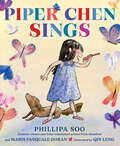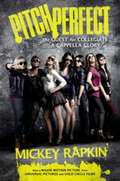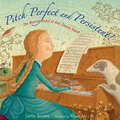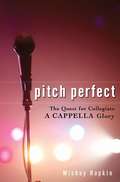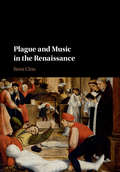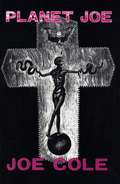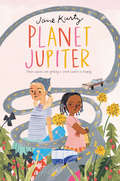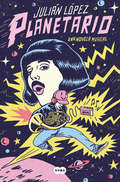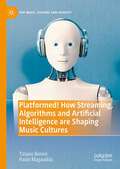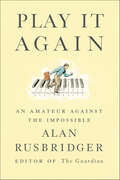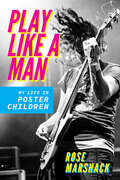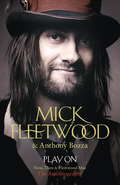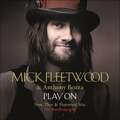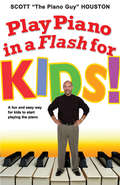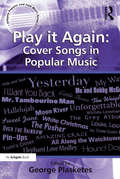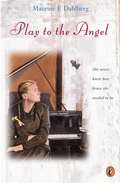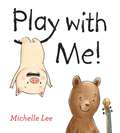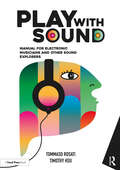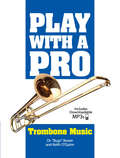- Table View
- List View
Piper Chen Sings
by Phillipa Soo Maris Pasquale DoranAn empowering story about a girl who turns her performance jitters into confidence when faced with singing a solo at her school concert. Inspired by the childhood experience of award-winning actress Phillipa Soo who originated the role of Eliza in Hamilton. <p><p>Piper Chen loves nothing more than to sing. She sings to the sun, and she sings to the moon. She sings to her stuffed animals and with the birds outside her window. So, when her music teacher asks if Piper would like to sing a solo in her school’s Spring Sing, all she can say is “yes!” But as practice continues, doubt and worry creep in and Piper’s confidence wavers. She feels like butterflies are having a dance party in her belly. At home, Piper finds Nai Nai, her grandmother, at the piano. They’ve always shared a love of music, and Piper knows if anyone can help her through the unsettling feeling in her stomach and to shine her brightest at the Spring Concert, it’s Nai Nai. <p><p>First time picture book writers and sisters-in-law, Phillipa Soo and Maris Pasquale Doran along with acclaimed illustrator Qin Leng have created a cheerful intergenerational and stunning story that inspires confidence in the face of nervousness <p> <b>New York Times Bestseller</b>
Pitch Perfect (movie tie-in)
by Mickey RapkinA musical tale of collegiate a cappella filled of high notes, high drama, and high jinks is now a major motion picture. Get ready to be pitch slapped. The roots of unaccompanied vocal music stretch all the way back to Gregorian chants of the Middle Ages, and collegiate a cappella is over a century old. But what was once largely an Ivy League phenomenon has, in the past twenty years, exploded. And it's not what you think. Though the blue blazers and khakis may remain, a cappella groups at colleges across the country have become downright funky. In Pitch Perfect, journalist Mickey Rapkin follows a season in a cappella through all its twists and turns, covering the breathtaking displays of vocal talent, the groupies (yes, there are a cappella groupies), the rock-star partying, and all the bitter rivalries. Rapkin brings you into the world of collegiate a cappella characters--from movie-star looks and celebrity-size egos to a troubled new singer with the megawatt voice. Including encounters with a cappella alums like John Legend and Diane Sawyer and fans from Prince to presidents, Rapkin shows that a cappella isn't for the faint of heart--or lungs. Sure to strikea chord with fans of Glee and The Sing-Off, this raucous story of a cappella rock stars shows that sometimes, to get that perfect harmony, you have to embrace a little discord.
Pitch Perfect and Persistent!: The Musical Debut of Amy Cheney Beach
by Caitlin DeLemsDiscover the untold yet inspiring story of Amy Beach, musician extraordinaire and the first successful woman composer in America.With perfect pitch and fierce persistence, Amy Beach always knew she had to make music. There was just one BIG problem. Her mother believed it was not proper or suitable for a young lady to draw attention to herself, let alone take on a musical career. But give in or give up? Not Amy Beach. She demanded to play the piano. Demanded to have a real teacher. Demanded to perform. Luckily—for the world!—Amy&’s persistence paid off. At just sixteen years old, Amy Beach found herself on the stage of Boston&’s Music Hall—and the start of a brilliant career. A female composer who paved the way—perfectly!
Pitch Perfect: The Quest for Collegiate A Cappella Glory
by Mickey RapkinPitch Perfectis a behind-the-scenes look at the bizarre, often inspiring world of collegiate a cappella groups. The first collegiate a cappella group, the Yale Whiffenpoofs, was founded by Cole Porter back in 1909. But what had been largely an Ivy League phenomenon has, in the past fifteen years, exploded. And it’s not what you think. There are now more than 1,200 a cappella groups at colleges across the country. The very best of these collegiate groups square off in the annual International Championship of Collegiate A Cappella—a showdown marked by wrenching close calls and exhilarating triumphs. And, really, where else can you hear Michael Jackson’s “Bad” in four-part harmony? In Pitch Perfect, GQ editor Mickey Rapkin follows a season in a cappella through all its twists and turns, covering the breathtaking displays of vocal talent, the groupies (yes, a cappella singers have groupies), the rockstar partying (and run-ins with the law), and all the bitter rivalries. Along the way are encounters with boldfaced names such as President George W. Bush, Prince, David Letterman, Barack Obama, Barbra Streisand, Hillary Clinton, Marisa Tomei, Amanda Bynes, Nick Lachey, Merv Griffin, Jim Carrey, Microsoft’s Paul Allen, John Legend, and Jessica Biel. At the heart of the narrative are three a cappella groups whose interactions are anything but harmonious: the historic Tufts Beelzebubs, founded more than forty years ago with 40,000 albums sold since—and struggling to record a new album that lives up to the hype; Divisi of the University of Oregon, a relatively new, all-female group attempting to overcome a loss in the 2005 championship; and the University of Virginia Hullabahoos, the so-called bad boys of collegiate a cappella, who will attempt to compete on a higher level this year while retaining their casual soul. Bringing a lively new twist to America’s fascination with talent showdowns and peerless performers, Pitch Perfect is sure to strike a chord with readers.
Plague and Music in the Renaissance
by Remi ChiuPlague, a devastating and recurring affliction throughout the Renaissance, had a major impact on European life. Not only was pestilence a biological problem, but it was also read as a symptom of spiritual degeneracy and it caused widespread social disorder. Assembling a picture of the complex and sometimes contradictory responses to plague from medical, spiritual and civic perspectives, this book uncovers the place of music - whether regarded as an indispensable medicine or a moral poison that exacerbated outbreaks - in the management of the disease. This original musicological approach further reveals how composers responded, in their works, to the discourses and practices surrounding one of the greatest medical crises in the pre-modern age. Addressing topics such as music as therapy, public rituals and performance and music in religion, the volume also provides detailed musical analysis throughout to illustrate how pestilence affected societal attitudes toward music.
Planet Beethoven
by Mina YangIn Planet Beethoven, Mina Yang makes the compelling case that classical music in the twenty-first century is just as vibrant and relevant as ever--but with significant changes that give us insight into the major cultural shifts of our day. Perusing events, projects, programs, writings, musicians, and compositions, Yang shines a spotlight on the Western art music tradition. The book covers an array of topics, from the use of Beethoven's "Für Elise" in YouTube clips and hip-hop, to the marketing claims of Baby Einstein products, and the new forms of music education introduced by Gustavo Dudamel, conductor of the Los Angeles Philharmonic. While the book is global in its outlook, each chapter investigates the unique attributes of a specific performer, performance, or event. One chapter reflects on Chinese pianist Yuja Wang's controversial performance at the Hollywood Bowl, another explores the highly symbolic Passion 2000 Project in Stuttgart, Germany. Sure to be of interest to students, professionals, and aficionados, Planet Beethoven traces the tensions that arise from the "classical" nature of this tradition and our rapidly changing world.Ebook Edition Note: One image has been redacted.
Planet Joe
by Joe ColeLife on the road as seen through the eyes of Black Flag/Rollins Band roadie and Rollins confidante, Joe Cole. Tour journal documenting the final Black Flag tour and first Rollins Band tour.
Planet Jupiter
by Jane KurtzJupiter is used to being a planet of one, and she likes it that way. But then a cousin, who Jupiter never even knew existed, comes from Ethiopia to stay for the summer, and Jupiter is put in charge of taking care of her. A lyrical and memorable story of family, friendship, and community—perfect for fans of Katherine Hannigan’s Ida B and Holly Goldberg Sloan’s Counting by 7s.Jupiter and her family have spent their lives on the road, moving from town to town in a trusty old van and earning their living by playing music for tourists. But when their van breaks down, Jupiter’s mother rents an actual house in Portland for the summer so Jupiter’s annoying cousin Edom, recently adopted from Ethiopia, can stay with them. Luckily, Edom doesn’t want to be in Portland any more than Jupiter wants her there, and the two hatch a Grand Plan to send Edom back to her mother. In the process, Jupiter learns that community and family aren’t always what you expect them to be.A sweet, genuine story with themes of community, immigration, finances, family, and taking care of the environment that will appeal to fans of Cynthia Lord and Lynda Mullaly Hunt.
Planetario
by Julián LópezEl actor y cómico Julián López debuta en el panorama literario con una novela llena de sonidos y melodías, de emotividad y pequeños momentos, de tradición y modernidad. Un abuelo y su nieto tienden un puente en el que la música se convierte en refugio contra el alzhéimer y el olvido. Y los dos se dejan llevar por el hilo musical de toda una vida. Jota recorre la memoria de un tiempo en un pequeño pueblo del interior. Una infancia y una adolescencia marcadas por el amor hacia la música clásica y el descubrimiento de la voz de Freddie Mercury y las canciones de Queen. Planetario es una crónica sentimental sobre la vida en un pueblo de la España vacía durante los años ochenta y noventa, y sobre el poder evocador de la música.
Platformed! How Streaming, Algorithms and Artificial Intelligence are Shaping Music Cultures (Pop Music, Culture and Identity)
by Paolo Magaudda Tiziano BoniniGrounded in more than a decade of field research, this book uses empirical examples, quantitative data, and qualitative interviews with young music consumers as well as music industry professionals to understand how the platforms behind music production, distribution and listening work in our digital society. Bringing together the perspectives from science and technology studies, media studies, and the political economy of digital platforms, the book outlines the process of mutual construction between music digital platforms and the cultural value of music in today’s society, and also reflects on the complicated relationship between the power of platforms and the agency of listeners.
Play All Night!: Duane Allman and the Journey to Fillmore East
by Bob BeattyThe origin story of a groundbreaking album The 1971 Allman Brothers Band album At Fillmore East was a musical manifesto years in the making. In Play All Night!, Bob Beatty dives deep into the motivations and musical background of band founder Duane Allman to tell the story of what made this album not just a smash hit, but one of the most important live rock albums in history. Featuring insights from bootleg tapes, radio ads, early reviews, never-before-published photos, and the memories of band members, fans, and friends, Beatty chronicles how Allman rejected the traditional route of music business success—hit singles and record sales—and built a band that was at its best jamming live on stage, feeding off the crowd’s energy, and pushing each other to new heights of virtuosic improvisation. Every challenge, from recruiting a group of relatively unknown but established musicians like Jaimoe and Dickey Betts, touring the American South as an interracial band, and the failure of their first two studio albums, sharpened Allman’s determination to pursue the band’s truly unique sound. He made a bold choice—to record their next album live at Bill Graham’s famous concert hall in New York’s Lower East Side, a gamble that launched a new strand of American music to the top of the charts. Four days after the album went gold, Duane Allman was killed in a motorcycle accident. He was 24. This book explores how At Fillmore East cemented Allman’s legacy as a strong-willed, self-taught visionary, giving fans of Southern rock and all readers interested in the role of rock music in American popular culture a new appreciation for this pathbreaking album.
Play It Again: An Amateur Against the Impossible
by Alan RusbridgerThe Guardian editor and amateur pianist’s account of a remarkable musical challenge during an extraordinary year for news.As editor of the Guardian, one of the world’s foremost newspapers, Alan Rusbridger lives by the relentless twenty-four-hour news cycle. But increasingly in midlife, he feels the gravitational pull of music—especially the piano. He sets himself a formidable challenge: within a year, to fluently learn Chopin’s magnificent Ballade No. 1 in G minor, arguably one of the most difficult Romantic compositions in the repertory. With pyrotechnic passages that require feats of memory, dexterity, and power, the piece is one that causes alarm even in battle-hardened concert pianists.Under ideal circumstances, this would have been a daunting task. But the particular year Rusbridger chooses turns out to be one of frenetic intensity, beginning with WikiLeaks’ massive dump of state secrets and ending with the Guardian’s revelations about widespread phone hacking at News of the World. “In between, there were the Japanese tsunami, the Arab Spring, the English riots . . . and the death of Osama Bin Laden,” writes Rusbridger. The test would be to “nibble out” twenty minutes per day to do something totally unrelated to these events.Rusbridger’s subject is larger than any one piece of music: Play It Again deals with focus, discipline, and desire but is, above all, about the sanctity of one’s inner life in a world dominated by deadlines and distractions.Praise for Play It Again“An absorbing, adroitly crafted tale of humility, discipline and the sheer love of music . . . [Alan Rusbridger’s] triumph is an inspiration.” —Katie Hafner, The New York Times Book Review“A unique mélange of political and musical reportage . . . [Alan Rusbridger] illuminates not only print media in this digital age but also the changing role of the music within.” —Iain Burnside, The Observer (London)
Play It Loud: An Epic History of the Style, Sound, and Revolution of the Electric Guitar
by Brad Tolinski Carlos Santana Alan Di PernaBy the longtime editor-in-chief of Guitar World and a veteran rock journalist, an unprecedented history of the electric guitar, its explosive impact on music and culture, and the people who brought it to life.Spanning a century and encompassing some of guitar's greatest builders and players, from Les Paul to Keith Richards to Eddie Van Halen, Brad Tolinski and Alan di Perna bring the evolution of the guitar to roaring life. This is a story of inventors and iconoclasts, of scam artists, prodigies and mythologizers, as varied and original as the music they spawned. Play It Loud uses twelve landmark instruments, each of them a milestone in the progress of the electric guitar, to illustrate the chaos, conflict and passion it has inspired. It introduces Leo Fender, a man who couldn't play a note, but whose innovation helped transform the classical guitar into the explosive sound machine it is today. Some of the most significant social movements of the 20th century are indebted to the guitar: it was an essential part of Beatlemania and Woodstock; a mirror to the rise of the teenager as a social force; a linchpin of the punk movement's sound and ethos. And today the guitar has come full circle, with contemporary titans such as Jack White of The White Stripes and Dan Auerbach of The Black Keys bringing some of those earliest electric guitar forms back to the limelight. For generations, the electric guitar has been an international symbol of freedom, danger and hedonism. Play It Loud is the story of how a band of innovators transformed a simple notion into a singular cultural force.
Play It Loud: An Epic History of the Style, Sound, and Revolution of the Electric Guitar
by Brad Tolinski Carlos Santana Alan Di PernaAn unprecedented history of the electric guitar, its explosive impact on music and culture, and the players and builders who brought it to life For generations the electric guitar has been an international symbol of freedom, danger, rebellion, and hedonism. In Play It Loud, veteran music journalists Brad Tolinski and Alan di Perna bring the history of this iconic instrument to roaring life. It's a story of inventors and iconoclasts, of scam artists, prodigies, and mythologizers as varied and original as the instruments they spawned.Play It Loud uses twelve landmark guitars--each of them artistic milestones in their own right--to illustrate the conflict and passion the instruments have inspired. It introduces Leo Fender, a man who couldn't play a note but whose innovations helped transform the guitar into the explosive sound machine it is today. Some of the most significant social movements of the twentieth century are indebted to the guitar: It was an essential element in the fight for racial equality in the entertainment industry; a mirror to the rise of the teenager as social force; a linchpin of punk's sound and ethos. And today the guitar has come full circle, with contemporary titans such as Jack White of The White Stripes, Annie Clark (aka St. Vincent), and Dan Auerbach of The Black Keys bringing some of the earliest electric guitar forms back to the limelight.Featuring interviews with Les Paul, Keith Richards, Carlos Santana, Eddie Van Halen, Steve Vai, and dozens more players and creators, Play It Loud is the story of how a band of innovators transformed an idea into a revolution.From the Hardcover edition.
Play Like a Man: My Life in Poster Children (Music in American Life)
by Rose MarshackAs a member of Poster Children, Rose Marshack took part in entwined revolutions. Marshack and other women seized a much-elevated profile in music during the indie rock breakthrough while the advent of new digital technologies transformed the recording and marketing of music. Touring in a van, meeting your idols, juggling a programming job with music, keeping control and credibility, the perils of an independent record label (and the greater perils of a major)—Marshack chronicles the band’s day-to-day life and punctuates her account with excerpts from her tour reports and hard-learned lessons on how to rock, program, and teach while female. She also details the ways Poster Children applied punk’s DIY ethos to digital tech as a way to connect with fans via then-new media like pkids listservs, internet radio, and enhanced CDs. An inside look at a scene and a career, Play Like a Man is the evocative and humorous tale of one woman’s life in the trenches and online.
Play On: Now, Then and Fleetwood Mac
by Mick Fleetwood"After forty-six years of being on the road, now is the right time to look back in a way I've never done before: now and then. I'm looking forward to sharing it with you." Mick Fleetwood has been part of one of the world's most successful and adored bands for over four decades. Here he tells the full and candid story of that life, and what it is to be part of the ever evolving Fleetwood Mac. His all-access autobiography spans the career of one of classic rock's greatest drummers and band leaders, the co-founder of the deeply loved super group that bears his name. In this intimate portrait of a life lived in music, Fleetwood vividly recalls his upbringing in Cornwall, Egypt and Norway tapping along to whatever song was playing on the radio; his experiences as a musician in Sixties London; the early days of the band featuring Peter Green, and his close friendship with George Harrison and seemingly all of music royalty. Play On sheds new light on Fleetwood Mac's raucous history describing the highs and lows of being part of a band that he often single-handedly kept together. His love affair with Stevie Nicks, the creation of landmark albums like Rumours and Tusk, and the many incredible and outrageous moments of recording, touring, fighting, and loving with Fleetwood Mac: all are here. He describes his life's moments with the honesty and immediacy that his fans expect, taking us to the very heart of this multi layered life. It's been a tumultuous journey with the excesses of the band's huge success at times threatening to destroy what they strived so hard to create. But through it all it's been the drive to play on that has won out. Now, then, and always, it's Fleetwood Mac.
Play On: Now, Then and Fleetwood Mac
by Mick Fleetwood"After forty-six years of being on the road, now is the right time to look back in a way I've never done before: now and then. I'm looking forward to sharing it with you." Mick Fleetwood has been part of one of the world's most successful and adored bands for over four decades. Here he tells the full and candid story of that life, and what it is to be part of the ever evolving Fleetwood Mac. His all-access autobiography spans the career of one of classic rock's greatest drummers and band leaders, the co-founder of the deeply loved super group that bears his name. In this intimate portrait of a life lived in music, Fleetwood vividly recalls his upbringing in Cornwall, Egypt and Norway tapping along to whatever song was playing on the radio; his experiences as a musician in Sixties London; the early days of the band featuring Peter Green, and his close friendship with George Harrison and seemingly all of music royalty. Play On sheds new light on Fleetwood Mac's raucous history describing the highs and lows of being part of a band that he often single-handedly kept together. His love affair with Stevie Nicks, the creation of landmark albums like Rumours and Tusk, and the many incredible and outrageous moments of recording, touring, fighting, and loving with Fleetwood Mac: all are here. He describes his life's moments with the honesty and immediacy that his fans expect, taking us to the very heart of this multi layered life. It's been a tumultuous journey with the excesses of the band's huge success at times threatening to destroy what they strived so hard to create. But through it all it's been the drive to play on that has won out. Now, then, and always, it's Fleetwood Mac.(P)2014 Hodder & Stoughton
Play On: Now, Then, and Fleetwood Mac: The Autobiography
by Mick Fleetwood Anthony BozzaMick Fleetwood, the drummer and cofounder of the mega-selling band Fleetwood Mac, tells all.In this candid, intimate portrait of a life lived in music, Mick Fleetwood sheds new light on well-known points in his history, including many incredible moments of recording and touring with Fleetwood Mac, as well as personal insights from a man who has been a major player in blues and rock n' roll since his teens.The group Fleetwood Mac has sold over 140 million records worldwide, and they continue to attract a huge following, selling out their biggest arena tour ever in 2013, decades after their debut. Finally, the group's admirers will have a unique portrait of what made Mick and the rest of the group tick in the midst of their massive success and personal trials.
Play Piano in a Flash for Kids!: A Fun and Easy Way for Kids to Start Playing the Piano
by Scott HoustonGetting a child to play piano has never been easier!As seen on public television nationwide, Scott "The Piano Guy" Houston is the leading authority on fast and fun piano instruction. In Play Piano in a Flash for Kids! he simplifies his unique and effective method of learning to play piano, making it accessible to even the youngest want-to-be pianists. Highlighting popular, not classical, music, this book fosters and nourishes an early love for music by giving children the tools to play their favorite popular songs.Your child will be able to: Learn the basics of piano playing using a simple technique that pros use, which focuses on becoming a good player versus becoming a good notation reader Use easy-to-follow step-by-step illustrations that demonstrate each stage of learning Play popular music on the piano without having to learn how to read complicated sheet musicIt is a great book for kids who may have taken lessons previously but became frustrated by the long and complicated process. And all at a fraction of the cost of piano lessons!Both parents and children can have fun learning the piano or keyboard together, or children can work through the book on their own, with parents providing support only when needed. Play Piano in a Flash for Kids! is the perfect tool for parents or teachers to help their kids learn to play the piano quickly and easily.
Play Pretty Blues
by Snowden WrightThe mysteries of blues legend Robert Johnson's live and death long ago became myth. Part researched reconstruction, part vivid imagination, this lyrical novel brings Johnson alive through the voices of his six wives, revealing the husband and son inside the legend, illuminating the vacuum Johnson left in the worlds of those who loved him and those he would never meet.
Play it Again: Cover Songs In Popular Music (Ashgate Popular and Folk Music Series)
by George PlasketesCovering”the musical practice of one artist recording or performing another composer's song”has always been an attribute of popular music. In 2009, the internet database Second Hand Songs estimated that there are 40,000 songs with at least one cover version. Some of the more common variations of this "appropriationist" method of musical quotation include traditional forms such as patriotic anthems, religious hymns such as Amazing Grace, Muzak's instrumental interpretations, Christmas classics, and children's songs. Novelty and comedy collections from parodists such as Weird Al Yankovic also align in the cover category, as does the "larcenous art" of sampling, and technological variations in dance remixes and mash-ups. Film and television soundtracks and advertisers increasingly rely on versions of familiar pop tunes to assist in marketing their narratives and products. The cover phenomenon in popular culture may be viewed as a postmodern manifestation in music as artists revisit, reinterpret and re-examine a significant cross section of musical styles, periods, genres, individual records, and other artists and their catalogues of works.The cover complex, with its multiple variations, issues, contexts, and re-contextualizations comprises an important and rich popular culture text. These re-recordings represent artifacts which embody artistic, social, cultural, historical, commercial, biographical, and novel meanings. Through homage, allusion, apprenticeship, and parody, among other modes, these diverse musical quotations express, preserve, and distribute popular culture, popular music and their intersecting historical narratives. Play it Again represents the first collection of critical perspectives on the many facets of cover songs in popular music.
Play to the Angel
by Maurine F. DahlbergAustria in 1938 is under the shadow of the Nazis, but 12-year-old Greta doesn't notice--she cares only for her piano lessons with their new neighbor. Then the Nazis invade and Greta discovers her teacher's secret. His life is in danger, and she may be the only one who can help him.
Play with Me!
by Michelle LeePlaytime means very different things to these two spirited friendsPip is full of ideas for what to play: Dress up! Magicians! Dolls! Only, Nico doesn&’t want to play any of them, and Pip gets mad. REALLY mad. But don&’t worry—Nico finds the perfect way for them to play together. Michelle Lee&’s irresistible characters show that finding a way to play together will always hit the right note.
Play with Sound: Manual for Electronic Musicians and Other Sound Explorers
by Tommaso Rosati Timothy HsuPlay with Sound: Manual for Electronic Musicians and Other Sound Explorers offers a thorough introduction to music technology by centering on curiosity and creativity in the exploration of the fundamentals of sound.With color illustrations throughout, this book covers topics regarding audio software, acoustical principles, electroacoustic systems, audio processing, sound synthesis, and communication protocols. Each chapter features creative exercises that utilize live electronics, production, and composition to unearth the theories presented and develop technical and musical creativity. Additionally, interactive graphics and lesson slides are available as digital resources to enhance learning inside and outside the classroom.Play with Sound is an ideal textbook for beginners of all backgrounds looking for an introduction to music technology, production, and live electronics. By engaging with this book, everyone, including traditional students as well as those learning outside the traditional classroom setting, will be able to expand their musical skills and professional opportunities into the world of music technology.
Play with a Pro: Trombone Music
by Keith O'Quinn Dr Bugs BowerFrom Dixieland and boogie woogie to swing, blues, jazz, bop, Latin, and rock music, this title offers a variety of styles. Along with music to fifteen songs, downloadable MP3s provide a chance to play with a top Broadway trombonist.Each song is recorded three ways:1. Practice playing melody (1st trombone) or harmony (2nd trombone) with the title tracks, MP3s 1-15, marked TT.2. Practice playing melody (1st trombone) with accompaniment, MP3s 16-30, marked MT. 3. Practice playing harmony (2nd trombone) with accompaniment, MP3s 31-45, marked HT.These rehearsal routines are comparable to playing a 25-minute set with a live stage band!
